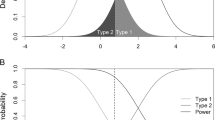Abstract
A power calculation is described in which the power of selective genotyping in genetic association studies of quantitative traits is evaluated. The method of selective genotyping implies the selection of the extremely high and low scoring individuals from the continuous distribution of a quantitative trait. The selected individuals are genotyped and association is tested. In the power calculation the following parameters are varied: total sample size of the phenotyped group (1000, 1500, 2000); selection of extremely high and low scoring individuals (2.5%, 5%, 10%); allele frequency of the risk increasing allele (0.10 to 0.90); mode of inheritance and proportion of variance explained by the quantitative trait locus ϖ = 0.01, 0.05, 0.10). We conclude that the method of selective genotyping is a powerful method to detect association for a quantitative trait.
Similar content being viewed by others
REFERENCES
Allison, D. B., Heo, M., Schork, N. J., Wong, S. L. and Elston, R. C. (1998). Extreme selection strategies in gene mapping studies of oligogenic quantitative traits do not always increase power. Human Heredity 48, 97–107.
Ball, D., Hill, L., Eley, T. C., Chorney, M. J., Chorney, K., Thompson, L. A., Detterman, D. K., Benbow, C., Lubinski, D., Owen, M., McGuffin, P., and Plomin, R. (1998). Dopamine markers and general cognitive ability. NeuroReport 9:347–349.
Ball, D., Hill, L., Freeman, B., Eley, T. C., Strelau, J., Riemann, R., Spinath, F. M., Angleitner, A., and Plomin, R. (1997). The serotonin transporter gene and peer-rated neuroticism. NeuroReport 8:1301–1304.
Darvasi, A., and Soller, M. (1992). Selective genotyping for determination of linkage between a marker locus and a quantitative trait locus. Theor.Appl.Genet. 85:353–359.
Morton, N. E., and Collins, A. C. (1998). Tests and estimates of allelic association in complex inheritance. Proceedings of the National Academy of Science USA 95:11389–11393.
Lander, E., and Botstein, D. (1989). Mapping Mendelian factors underlying quantitative traits using RFLP linkage maps. Genetics 121:185–199.
Petrill, S., Plomin, R., McClearn, G. E., Smith, D. L., Vignetti, S., Chorney, M. J., Chorney, K., Thompson, L. A., Detterman, D. K., Benbow, C., Lubinski, D., Daniels, J., Owen, M. and McGuffin, P. (1997). No association between general cognitive ability and the A1 allele of the D2 dopamine receptor gene. Behav.Genet. 27:29–31.
Plomin, R., McClearn, G. E., Smith, D. L., Vignetti, S., Chorney, M. J., Chorney, K., Venditti, C. P., Kasarda, S., Thompson, L. A., Detterman, D. K., Daniels, J., Owen, M., and McGuffin, P. (1994). DNA markers associated with high versus low IQ: The IQ quantitative trait loci (QTL) project. Behav.Genet. 24:107–118.
Rosner, B. (1995). Fundamentals of Biostatistics, 4 th Edition, Duxbury Press, USA, p. 385.
Vandenbergh, D. J., Zonderman, A. B., Wang, J., Uhl, G. R., and Costa, P. T. (1997). No association between Novelty Seeking and dopamine D4 receptor (D4DR) exon III seven repeat alleles in Baltimore Longitudinal Study of Aging Participants. Mol.Psychiatry 2:417–419.
Author information
Authors and Affiliations
Rights and permissions
About this article
Cite this article
Van Gestel, S., Houwing-Duistermaat, J.J., Adolfsson, R. et al. Power of Selective Genotyping in Genetic Association Analyses of Quantitative Traits. Behav Genet 30, 141–146 (2000). https://doi.org/10.1023/A:1001907321955
Issue Date:
DOI: https://doi.org/10.1023/A:1001907321955




